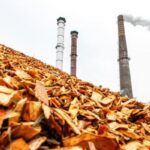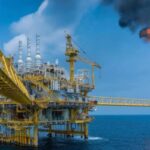We explain what fossil fuels are, how they are formed and examples. Uses, importance and the environmental impact they generate.

What are fossil fuels?
Fossil fuels (such as oil, coal, and natural gas) are those that come from the natural decomposition of organic matter (plants, microorganisms, bacteria and algae) after a transformation process that can last more than 600 million years.
They are called non-renewable energies because are limited natural resources since to form they require an extensive period of time and specific conditions. There is no other way to generate them and, despite this, they are the main source of energy throughout the world due to their high calorific value compared to other sources such as wind energy or solar energy.
Formation of fossil fuels

The organic matter accumulated for millions of years beneath the layers of the Earth's crust and at the bottom of lakes and seas undergoes various alterations due to increased soil pressure and temperature.
It is then transformed into different types of sedimentary rock or fossils that contain concentrated heat. This is how substances such as oil, coal or natural gas are created, which, Through excavation processes, they can be extracted from the depths of the ground. Then, through treatments, they can release that concentrated energy to become fuel.
Examples of fossil fuels
There are four types of fossil fuels:
- Coal It is a dark black sedimentary rock, rich in carbon and other chemical elements such as hydrogen, sulfur, oxygen and nitrogen. The extraction of this mineral can be carried out in two ways: through open pit mining (when the coal is less than 60 meters deep) or through underground mining.
Between the 19th century and the mid-20th century, trains, ships and industrial machinery ran thanks to the energy of this fuel. Despite having been surpassed by oil in terms of its energy capacity, today coal is used for the production of plastics and oils, among other uses. - Oil. It is an oily liquid composed of carbon and hydrogen (a combination called hydrocarbon) that is extracted from a well, between 600 and 5000 meters deep. To obtain it, drilling towers are installed that can be located on the earth's surface or on platforms in the sea. Plastic, printing inks, rubber for tire manufacturing, and gasoline can be produced from oil, among its main uses.
- Natural gas. It is a mixture of hydrocarbons in a gaseous state (mostly methane and to a lesser extent nitrogen, carbon dioxide, butane, among others). It is extracted with drilling towers and, through pipelines designed to transport gases on a large scale, it is directed to the power plants for subsequent transport by sea. Natural gas has no smell and is colorless, that is, we cannot perceive it with our senses. For this reason, a product with an odor is added to detect it in cases of leaks.
- Liquefied petroleum gas It is composed mainly of butane and propane, gases that are compressed into liquids, and is obtained as a byproduct of the oil or natural gas refining process. It is primarily used as an alternative fuel for gasoline-powered cars. Despite generating less power than gasoline, its differential advantages are the economical price and lower carbon dioxide emissions.
Uses and importance of fossil fuels

fossil fuels were discovered thousands of years ago. However, it was after the Industrial Revolution (in the mid-18th century) when they began to be used on a large scale in transportation and machinery.
Today fossil fuels are the main source of energy for societies because they release a large heat load, they can be transported easily and their production cost is cheaper compared to other alternative sources. They are used to generate electrical energy and, mainly, mechanical energy (for machinery, automobiles, airplanes, etc.).
They have multiple uses, such as:
- Residential Derivatives of petroleum and natural gas can be used in equipment such as the heater, the stove, the jug, the electric generator, among others.
- Commercial They can be used in a similar way to residential but on a larger scale. For example, in central heating systems.
- Agricultural They are used for equipment that generates hot air in greenhouses, for irrigation pumps, and machinery that works the land, among the main ones.
- Industrial Natural gas is used in production machinery, such as ovens, dryers or boilers.
- Transport Derivatives of petroleum and natural gas are used as fuel for automobiles, to facilitate cleaner combustion of engines or as a coolant.
Environmental impact

The process of extracting fossil fuels is harmful to the environment. Drilling work operates 24 hours a day, disrupting the habitat order almost completely. The following problems may occur:
- ecological damage The increase in vehicle traffic, the deployment of work machinery and the activity of workers harm the fauna. Alterations in the relationship between predators and prey have been recorded, as well as the interruption of communication between songbirds during the nesting season and breeding.
- Spills. The liquids used during the excavation process are discarded in parallel pits for subsequent treatment. However, sometimes they spill partially and their long-term impact can cause damage to the land and affect the health of the inhabitants. Offshore oil spills affect marine animals through direct contact, inhalation and ingestion of the liquids.
- Changes in the landscape. The construction of roads to transport the necessary machinery to the excavation area causes the partial or total elimination of vegetation and increases soil erosion. This wear and tear, which is carried out in an accelerated manner, causes damage that impacts local agriculture: it causes flooding and generates loss of the upper layers of the sleep rich in nutrients, among the main problems.
- Water and air pollution Parallel pits used to dump waste are open pits that may contain wastewater, chemicals, petroleum hydrocarbons, and other substances that compromise the safety of drinking water. Pipe and well explosions sometimes occur, despite having been drilled properly. This causes contamination of aquifers and air, due to the release of methane gas and carbon dioxide, which in large quantities are harmful to the atmosphere and the local environment.
References
- “Fossil Fuels” in Energies of my Country.
- “How does the extraction of fossil fuels affect the environment?” in Ecoticias.
- «Fossil Fuels» in Green Renewables.
- «Fossil Fuel Uses» in Helpsavenature.
- “What is primary energy?” at Twinenergy.
- “Non-Renewable Energy” in Wikipedia.
- “Fossil Fuel” on Wikipedia.
- «Renewable Energies» in Scielo (PDF).
- “Natural Gas” in Energy Explained.
- «LPG: what is it and what is it for?» in Motor Passion.
- “Autogas” in Wikipedia.





